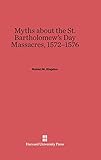Myths about the St. Bartholomew’s Day Massacres, 1572–1576 / Robert M. Kingdon.
Material type: TextPublisher: Cambridge, MA : Harvard University Press, [2013]Copyright date: ©1988Edition: Reprint 2014Description: 1 online resource (269 p.) : illustrationsContent type:
TextPublisher: Cambridge, MA : Harvard University Press, [2013]Copyright date: ©1988Edition: Reprint 2014Description: 1 online resource (269 p.) : illustrationsContent type: - 9780674182196
- 9780674182202
- Bartholomäusnacht
- Bartholomeüsnacht
- Bartholomeüsnacht
- Bartholomäusnacht
- Geschichte Europas
- Huguenots
- Pamphlet
- Propaganda
- Protestanten
- Rezeption
- Saint Bartholomew's Day, Massacre of, France, 1572
- Saint-Barthélemy, Massacre de la, 1572
- France -- History -- Wars of the Huguenots, 1562-1598
- HISTORY / General
- HISTORY / Modern / 16th Century
- RELIGION / Christianity / Protestant
- Saint Bartholomew's Day, Massacre of, France, 1572
- HISTORY / General
- 944/.029
- DC118
- online - DeGruyter
| Item type | Current library | Call number | URL | Status | Notes | Barcode | |
|---|---|---|---|---|---|---|---|
 eBook
eBook
|
Biblioteca "Angelicum" Pont. Univ. S.Tommaso d'Aquino Nuvola online | online - DeGruyter (Browse shelf(Opens below)) | Online access | Not for loan (Accesso limitato) | Accesso per gli utenti autorizzati / Access for authorized users | (dgr)9780674182202 |
Frontmatter -- Acknowledgments -- Contents -- Illustrations -- Introduction -- 1. The Role of the Printing Press -- 2. The Hero: Gaspard de Coligny -- 3. Heroic Communities: Sancerre and La Rochelle -- 4. International Propaganda: The Reveille-matin -- 5. Appeals to the Poles -- 6. Appeals to the Swiss and the Germans -- 7. Appeals to the English -- 8. An Appeal to the Estates-General: The Franco-Gallia -- 9. An Appeal to Inferior Magistrates: Du droit des magistrats -- 10. Appeals to the People: The Politique and the Discours de la servitude volontaire -- 11. Tyrannicide: The Discours politiques -- 12. Political Assemblies and the Search for a New Hero -- 13. The Villain: Catherine de Médicis -- Conclusion -- Abbreviations. Notes. Bibliography. Index -- Abbreviations -- Notes -- Bibliography -- Index
restricted access online access with authorization star
http://purl.org/coar/access_right/c_16ec
An epochal event in French history, the St. Bartholomew's Day religious massacres are still the subject of controversy. A leading historian of the early modern period, Robert Kingdon, writes about the reactions to the massacres that were published at the time, showing how the relatively new medium of print was used by the Protestants to shape reaction to the catastrophe an early example of the printing press as an agent of social and political change. Kingdon describes the loosely connected network of printers in Geneva, Basel, Strasbourg, Frankfurt, Heidelberg, London, La Rochelle, and other cities that printed and distributed the grisly accounts of the murders of thousands of Protestants by Catholic zealots. But the pamphlets encompassed more than the making of martyrs. Some linked the massacres with an evil international conspiracy led by the French monarchy, Rome, and Spain. Others were political treatises arguing for a type of government that would no longer claim absolute power and would permit the survival of an ideological minority. Thus, the book contributes to an understanding of the history of printed propaganda and the role of myths in historical events, and illuminates important aspects of international diplomacy and political thought during the period of the later Reformation.
Mode of access: Internet via World Wide Web.
In English.
Description based on online resource; title from PDF title page (publisher's Web site, viewed 24. Aug 2021)


